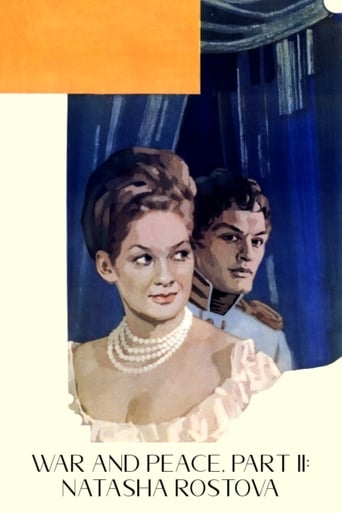



I think this is a new genre that they're all sort of working their way through it and haven't got all the kinks worked out yet but it's a genre that works for me.
View MoreA film of deceptively outspoken contemporary relevance, this is cinema at its most alert, alarming and alive.
View MoreEach character in this movie — down to the smallest one — is an individual rather than a type, prone to spontaneous changes of mood and sometimes amusing outbursts of pettiness or ill humor.
View MoreBlistering performances.
Well, consider me astonished! Part Two of Sergei Bondarchuk's epic adaptation of "War and Peace" contains not a single gruesome war-time death, and yet I think I enjoyed it more than the previous instalment. 'Voyna i mir II: Natasha Rostova (1966)' almost entirely follows the exploits of the title character Natasha Rostova (Lyudmila Savelyeva), the adolescent daughter of a countess. Napoleon has signed a treaty with Russia, and thoughts of war have momentarily drifted from the minds of its inhabitants, who now turn their attention towards the equally-tragic themes of love, friendship, hatred and passion. If we'd expected peace to have provided temporary relief from the carnage and chaos of conflict, we're certainly offered some reassurance, but the story's major position seems to be that heartbreak is hardly restricted to the horrors of war. Human relationships are delicate and potentially-implosive entities, and the conflicting emotions offered by the heart can often result in tragic consequences, condemning fresh young personalities to a lifetime of unfulfillment and dissatisfaction.Part One of 'War and Peace' gave us our first glimpse of Natasha Rostova, as a bright-eyed and giggling youngster yearning for her first romance. By the conclusion of Part Two, she will have forever bid farewell to her childhood, and have entered the sobering years of adulthood, heartbroken and disillusioned. The film's first major set-piece perhaps rivalling Bondarchuk's own battle recreations in scope and attention-to-detail is a breathtaking New Year's Eve ball, adorned by hundreds of elaborately-costumed dancers who sweep across the floor with impeccable grace. Displaying a versatility that calls to mind a similar sequence in Orson Welles' 'The Magnificent Ambersons (1942),' Bondarchuk's camera glides majestically amid the flurry of waltzing couples, while retaining its intimacy through focusing the spectacle largely from Natasha's perspective. It is here that the blossoming beauty again makes acquaintance with Prince Andrei Bolkonsky, whose wife had previously passed away during childbirth. Andrei immediately confirms his love for Natasha, whose enthusiasm for life had offered the war-weary soldier a fresh opportunity at happiness.Lyudmila Savelyeva really is very impressive in the main role, undergoing a dramatic transformation from shy débutante to disgraced lover. By the film's end, following her liaison and attempted elopement with a married man, Andrei finds that everything he'd loved about Natasha her youthful naiveté, her fervor towards the wider world has evaporated in a cruel rite-of-passage, and he regretfully rejects any future with her. Natasha's emotional maturement is also reflected in a noticeable physical transformation, and that Bondarchuk filmed the 'War and Peace' over a number of years would certainly have been beneficial in communicating her character's growth. Savelyeva at times boasts a striking resemblance to Audrey Hepburn, who played the same role in King Vidor's 'War and Peace (1956),' and her character bears similarities to Vivien Leigh as Scarlett O'Hara, though she distinctly lacks the resolve to handle the troubles brought forth by her own dishonourable actions. Whereas Part One attempted to cover too many narrative threads, thereby sacrificing our emotional attachment to any of the characters, Part Two effectively addresses this issue, and, as for Natasha, our hearts are with her.
View More